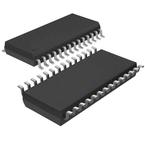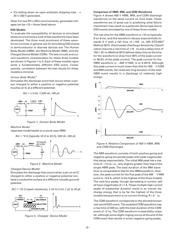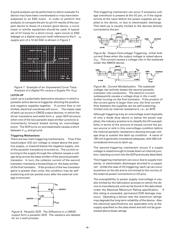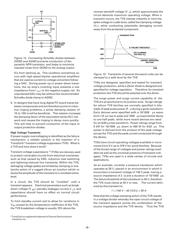Datasheet 搜索 > AD转换器 > ADI(亚德诺) > AD7708BRU 数据手册 > AD7708BRU 其他数据使用手册 2/8 页

 器件3D模型
器件3D模型¥ 7.184
AD7708BRU 其他数据使用手册 - ADI(亚德诺)
制造商:
ADI(亚德诺)
分类:
AD转换器
封装:
TSSOP-28
描述:
8 / 10通道,低电压,低功耗,模数转换器 8-/10-Channel, Low Voltage, Low Power, ADCs
Pictures:
3D模型
符号图
焊盘图
引脚图
产品图
页面导航:
技术参数、封装参数在P4
应用领域在P7P8
导航目录
AD7708BRU数据手册
Page:
of 8 Go
若手册格式错乱,请下载阅览PDF原文件

–2–
• ICs sliding down an open antistatic shipping tube ⇒
25 V–250 V generated.
Note
: For low RH (<30%) environments, generated volt-
ages can be >10 × those listed above.
ESD Models
To evaluate the susceptibility of devices to simulated
stress environments a host of test waveforms have been
developed. The three most prominent of these wave-
forms currently in general use for simulating ESD events
in semiconductor or discrete devices are: The Human
Body Model (HBM), the Machine Model (MM), and the
Charged Device Model (CDM). The test circuits and cur-
rent waveform characteristics for these three models
are shown in Figures 1 to 3. Each of these models repre-
sents a fundamentally different ESD event. Conse-
quently, correlation between the test results for these
models is minimal.
Human Body Model:
2
Simulates the discharge event that occurs when a per-
son charged to either a positive or negative potential
touches an IC at a different potential.
HVPS
10MΩ
1.5kΩ
100pF
S1
DUT
I
t
Figure 1. Human Body Model
Machine Model:
Japanese model based on a worst-case HBM.
I
t
HVPS
10MΩ
500nH
200pF
S1
DUT
Figure 2. Machine Model
Charged Device Model:
Simulates the discharge that occurs when a pin on an IC
charged to either a positive or negative potential con-
tacts a conductive surface at a different (usually ground)
potential.
HVPS
1GΩ
1Ω
DIELECTRIC
GROUND PLANE
DISCHARGE
CHARGE
I
t
Figure 3. Charged Device Model
Comparison of HBM, MM, and CDM Waveforms
Figure 4 shows 400 V HBM, MM, and CDM discharge
waveforms on the same current vs. time scale. These
waveforms are of great use in predicting what failure
mechanism may result on a particular device type due to
ESD events simulated by one of these three models.
The rise time for the HBM waveform is <10 ns (typically
6 ns–9 ns), and this waveform decays exponentially to-
wards 0 V with a fall time of >150 ns. MIL-STD-883
3
Method 3015
Electrostatic Discharge Sensitivity Classifi-
cation
requires a rise time of <10 ns and a delay time of
150 ± 20 ns (Method 3015 defines delay time as the time
for the waveform to drop from 90% of the peak current
to 36.8% of the peak current). The peak current for the
HBM waveform is ≈400 V/1500 Ω or 0.267A. Although
this peak current is much lower than that for 400 V CDM
and MM events, the relatively long duration of the total
HBM event results in a discharge of relatively high
energy.
AMPS
2
HBM
20ns/DIV
t
6
4
2
0
–2
–4
AMPS
MM
20ns/DIV
t
2
AMPS
CDM
20ns/DIV
t
Figure 4. Relative Comparison of 400 V HBM, MM,
and CDM Discharges
The MM waveform consists of both positive-going and
negative-going sinusoidal peaks with peak magnitudes
that decay exponentially. The initial MM peak has a rise
time of ≈14 ns, i.e., only slightly greater than that of the
single HBM peak. The total duration of the MM wave-
form is comparable to that for the HBM waveform. How-
ever, the peak current for the first peak of the 400 V MM
event is ≈5.8 A, which is the highest of the three models.
The next four peaks, though decreasing in current, still
all have magnitudes of >1 A. These multiple high current
peaks of substantial duration result in an overall dis-
charge energy that is by far the highest of the three
models because there is no current limiting; R = 0 Ω.
The CDM waveform corresponds to the shortest known
real-world ESD event. The socketed CDM waveform has
a rise time of 400 ps, with the total duration of the CDM
event of ≈2 ns. The CDM waveform is essentially unipo-
lar, although some slight ringing occurs at the end of the
CDM event that results in some negative-going peaks.
RLC=1.5kɏ,7,500nH,100pF.
~0ɏ(typically
10ɏto20ɏ)
7,500nH
RLC=~0ɏ(typically10ɏto20ɏ),500nH,200pF.
RLC=~25ɏ(sparkresistance),1nHto5nH,1pFto20pF.
器件 Datasheet 文档搜索
AiEMA 数据库涵盖高达 72,405,303 个元件的数据手册,每天更新 5,000 多个 PDF 文件






